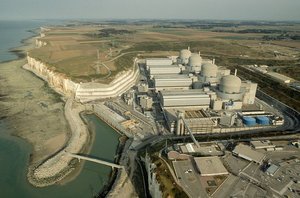Atomic Energy Act, United States
The Atomic Energy Act, first passed in 1946, is the the fundamental U.S. law on both the civilian and the military uses of nuclear materials. The Act established the Atomic Energy Commission (AEC), the agency initially responsible for overseeing all nuclear activities in the United States. The AEC succeeded the Manhattan Engineer District of the U.S. Army Corps of Engineers, who, as part of the Manhattan Project, developed the atomic bomb during World War II that was tested at the Trinity Site in New Mexico in 1945 and later used in the bombings of Japan to end the war.
In 1954, the Act was revised to permit private industry to build nuclear reactors for the generation of electricity. The Act requires civilian uses of nuclear materials and facilities be licensed, and it empowers the AEC and its successor, the Nuclear Regulatory Commission (NRC), to establish and enforce health and safety standards related to nuclear activities. Under the Energy Reorganization Act of 1974, the AEC was abolished, and two new federal agencies were established in its place to administer and regulate atomic energy activities: the Energy Research and Development Administration (ERDA) and the Nuclear Regulatory Commission (NRC). In 1977, the responsibilities of the ERDA were transferred to the newly established United States Department of Energy (U.S. DOE).
On the civilian side, the Act provides for both the development and the regulation of the uses of nuclear materials and facilities in the United States, declaring the policy that "the development, use, and control of atomic energy shall be directed so as to promote world peace, improve the general welfare, increase the standard of living, and strengthen free competition in private enterprise." The Act requires that civilian uses of nuclear materials and facilities be licensed, and it empowers the AEC, and its successor, the Nuclear Regulatory Commission (NRC) to establish by rule or order, and to enforce, such standards to govern these uses as "the Commission may deem necessary or desirable in order to protect health and safety and minimize danger to life or property." Commission action under the Act must conform to the Act’s procedural requirements, which provide an opportunity for hearings and Federal judicial review in many instances.
Under section 274 of the Act, the NRC may enter into an agreement with a State for discontinuance of the NRC’s regulatory authority over some materials licensees within the State. The State must first show that its regulatory program is compatible with the NRC’s and adequate to protect public health and safety. The NRC retains authority over, among other things, nuclear power plants within the State and exports from the State.
A major amendment to the Act established compensation for, and limits on, licensee liability for injury to off-site persons or damage to property caused by nuclear accidents.
The Energy Reorganization Act of 1974, established the Nuclear Regulatory Commission. Under the Atomic Energy Act of 1954, a single agency, the Atomic Energy Commission (AEC), had responsibility for the development and production of nuclear weapons and for both the development and the safety regulation of the civilian uses of nuclear materials. The Act of 1974 split these functions, assigning to one agency, now the Department of Energy, the responsibility for the development and production of nuclear weapons, promotion of nuclear power, and other energy-related work, and assigning to the NRC the regulatory work, which does not include regulation of defense nuclear facilities. The Act of 1974 gave the Commission its collegial structure and established its major offices. The later amendment to the Act also provided protections for employees who raise nuclear safety concerns.
Further Reading
The Atomic Energy Act of 1954 (U.S. Nuclear Regulatory Commission)
